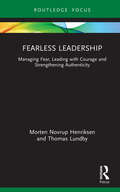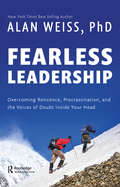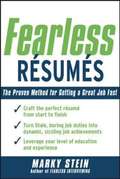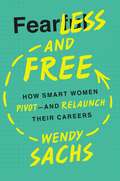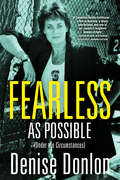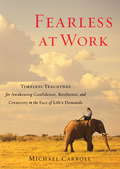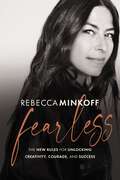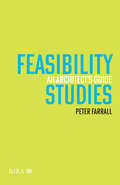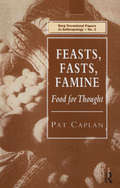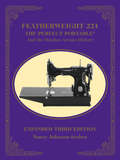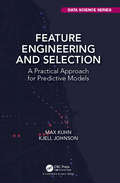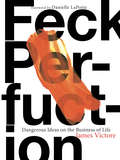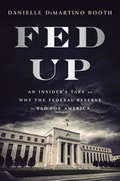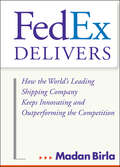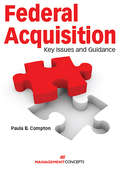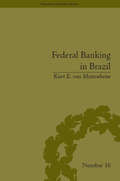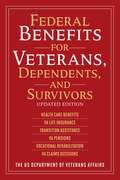- Table View
- List View
Fearless Leadership: Managing Fear, Leading with Courage and Strengthening Authenticity (Routledge Focus on Business and Management)
by Morten Henriksen Thomas LundbyAll management starts with self-management – handle fear and become an authentic leader. Often, the problem with management is not theoretical, but practical. Managers know enough about leadership, but a lot of them do not act accordingly. They know what should be done in a given situation but fear the discomfort and uncertainty that comes with it. The fear keeps many managers from stepping up to their responsibility. Therefore, the fear in leadership is playing a decisive role in the life and effectiveness of organizations. Based on research on the theoretical knowledge and the practical behavior of managers, combined with a long-time experience as consultants, the authors argue for the importance of practical judgment and emotional courage in management. This is essential in acting as an authentic leader, who does not feel paralyzed and trapped in paradoxes. Management books typically address the question of "what is good management," whereas this book is concerned with how to practice good management by exercising fearless leadership and emotional courage. It is a practical book that aims at inspiring the reader to act by providing specific tools and methods and will be of value to researchers, academics, practitioners, and students in the fields of leadership, strategic management, organizational studies and behavior, management development, and industrial and organizational psychology.
Fearless Leadership: Overcoming Reticence, Procrastination, and the Voices of Doubt Inside Your Head
by Alan WeissThe intent of this book -- the author's goal for you — is to understand the baseless underpinnings of almost all our fears. You read that correctly -- almost all our fears -- and therefore to discard them. The author has expertly coached leaders and managers in the discovery of, examination of, elimination of, and sustained freedom from fears. We all know people who are charming and articulate, but flounder on a stage addressing colleagues; musicians who master intricate scores but can’t play the basics when asked to solo; athletes who "choke"; business people who are strong until it comes time to ask for the business; people who consistently feel like "imposters." We are far better at dealing with external, tangible fears than our own imagined ones. We purchase insurance, watch the safety demonstrations, know how to use the Heimlich Maneuver. But those are responses to rare and often never-occurring emergencies. Our mythical and monstrous fears are daily dark clouds, masking our talents no less than depression or guilt. It’s time to realize there is no monster under the bed, never has been, and never will be without having to check nightly and without needing a weapon on the night table. Picture yourself freed of restraints that you could never properly articulate and were loath to discuss, but which you carried on your shoulders constantly, a dead weight, nonetheless. Essentially, this book is for entrepreneurs, business owners, and those who seek a better position for themselves and their talents, but who procrastinate, delay, and hang back. It’s about isolating and overcoming the internal fears that we generate every day like a geyser, triggered by time, events, or shifts in the environment. We are our own worst enemies and we ignore the practical remedies to escape fear because we use our energies instead on blaming everyone else.
Fearless Resumes: The Proven Method for Getting a Great Job Fast
by Marky SteinBack Cover: "Bestselling author and renowned career coach Marky Stein provides the edge you need in today's ultracompetitive job market. With Fearless Résumés you will transform your résumé from words on paper into a vibrant self-presentation that tells prospective employers what they want to hear. In no time, you'll be crafting a résumé that hooks prospective employers' attention, turns boring past duties into dynamic personal statements, transforms weaknesses into strengths--and gets your name on top of the résumé heap in any HR office. Fearless Résumés shows how to USE WORDS AND PHRASES EMPLOYERS LOOK FOR PROVE YOUR VALUE TO THE COMPANY TURN WEAKNESSES INTO STRENGTHS AVOID COMMON SNARES Unlike dry, run-of-the-mill guides consisting of little more than a sample résumé, Fearless Résumés is a quick and fun book that provides a proven résumé-crafting strategy from a top expert in her field."
Fearless and Free: How Smart Women Pivot--and Relaunch Their Careers
by Wendy SachsIn Fearless and Free, author Wendy Sachs provides pithy, invaluable guidance to women stymied in the workplace.Women tend to be inherently cautious, to the point of overthinking their every move. This may help them stay safer than their male counterparts, but it also keeps them stuck in the action-first, fake-it-til-you-make-it ethos celebrated in the tech world shaking up the workforce today.What if women embraced the startup spirit? What if they had the confidence to take chances, even if they knew they may fail first? What if instead of agonizing over which step to take, they leapt forward quickly? These are the traits that helped Silicon Valley redefine our culture, and not surprisingly, these are the same lessons that can help all women succeed in all stages of their careers.With lessons learned from a wide range of women who faced down fears, roadblocks, and failures to reinvent themselves, Sachs&’s invaluable resource teaches women how to:Boost their confidenceSell their storyCapitalize on their skills and expand themNurture their networkBrand themselves--without braggingReposition themselves for reentering the workforceBy taking the disruptive methods that helped Silicon Valley send shockwaves across industries, Fearless and Free seeks to empower women in the workforce, showing them how to lean into their strengths, increase confidence, and make their impact known loud and clear.
Fearless as Possible (Under the Circumstances): A Memoir
by Denise DonlonIn this smart, funny, and inspiring memoir, Denise Donlon recounts her journey as a corporate leader at the forefront of the massive changes in the Canadian music and media industries.One of Canada’s most celebrated and dynamic corporate leaders and broadcasters, Denise Donlon has long been recognized as a trailblazer in the Canadian cultural industries. In Fearless as Possible (Under the Circumstances), Donlon chronicles her impressive and storied career at MuchMusic, Sony Music Canada, and CBC English Radio, which put her at the forefront of the massive changes in the music industry and media. Throughout her incredible journey, she shares colourful and entertaining stories of growing up tall, flat, and bullied in east Scarborough; interviewing musical icons such as Keith Richards, Run-DMC, Ice-T, Joni Mitchell, Neil Young, Annie Lennox, and Sting; and detailing her life-changing experiences with War Child Canada, Live8, and the Clinton Giustra Enterprise Partnership.Told with humour and honesty, Fearless as Possible (Under the Circumstances) is a candid memoir of one woman’s journey, navigating corporate culture with integrity, responsibility, and an irrepressible passion to be a force for good.
Fearless at Work: Timeless Teachings for Awakening Confidence, Resilience, and Creativity in the F ace of Life's Demands
by Michael CarrollWork is such a crucial part of our life, and yet we often struggle with--and feel overwhelmed by--the numerous challenges it presents us. Whether it's job insecurity, making peace with or leaving an unfulfilling job, or dealing with office conflicts, we often experience fear and a sense of groundlessness just at a time when we want to be our most creative and resilient. Drawing on Buddhist philosophy, Michael Carroll, a longtime human-resources executive, meditation teacher, and executive coach, explains how the practice of mindfulness--full awareness of our moment-to-moment experience--can help us become more confident and open to possibility in our work life. He offers a system of potent, inspiring principles that we can use as a practice for helping us work with our insecurities and awakening our natural bravery, resourcefulness, and resilience.
Fearless: The New Rules for Unlocking Creativity, Courage, and Success
by Rebecca MinkoffTake your rightful place in the driver&’s seat of your own life and career through the focused and fearless strategies that only highly respected, incredibly successful luxury fashion mogul and social activist Rebecca Minkoff could lay out in these pages.Rebecca Minkoff built a fashion empire through hard work and a relentless drive to live her dream. It wasn&’t easy and took tremendous resolve to remain hungry and persevere. By never giving up, she has created a space for herself on the shelves of luxury department stores across the world.From Rebecca&’s experience, readers will learn how to:Take on challenges they initially didn&’t know how to complete, using Rebecca&’s fearless approach to push themselves to meet each and every one.Overcome the fear and trials female entrepreneurs often face.Break the rules and find success in places they previously thought to be inaccessible.Reach their goals, no matter how unattainable they may seem.In this book, Rebecca shares her own stories and teaches readers how she was able to reach her goals to become the successful fashion designer she is today. She shows that if you remain hungry, work hard, and face the unspoken rules that have held women back for centuries, you can make success happen for yourself.
Fearon's Careers
by Marna OwenThis book is for people who want to create their own great careers--careers that are just right for them. Fearon's Careers will introduce you to a career-planning process. As you work through this process, you'll discover important things about the world and about yourself. You will also learn and practice skills to prepare you for finding work that is right for you. Once you learn these skills, you will be able to practice them again and again throughout your life as you and the world change.
Feasibility Studies: An Architect’s Guide
by Peter FarrallFind that you’re spending much longer than planned on a feasibility study? Or that you have drifted into detailed design without formalising an appropriate form of appointment? This practical guide details the benefits of a feasibility study. Once you’ve secured the commission, how do you ensure you’re following current best practice? Aimed at architects, it identifies the pitfalls involved in undertaking a feasibility study and explains how to set boundaries, organise the process and manage clients’ aspirations. By featuring recent live projects, alongside advice from successful architectural practices, it illustrates how a feasibility study can help achieve positive outcomes and avoid the dangers of a poorly defined brief and service proposal. Presenting the client’s, as well as the architect’s, perspective, this publication highlights why a feasibility study is a sensible way of establishing viability prior to committing to a full-service commission. It underlines the significance of ‘adding value’ as an architect.
Feasibility of Using Mycoherbicides for Controlling Illicit Drug Crops
by Committee on Mycoherbicides for Eradicating Illicit Drug CropsThe control of illicit-drug trafficking and drug use is a difficult and complex process that involves a variety of prevention, control, treatment, and law enforcement strategies. Eradication strategies for controlling illicit-drug crops are used to target the beginning of the drug-supply chain by preventing or reducing crop yields. Mycoherbicides have been proposed as an eradication tool to supplement the current methods of herbicide spraying, mechanical removal, and manual destruction of illicit-drug crops. Some people regard them as preferable to chemical herbicides for controlling illicit-drug crops because of their purported specificity to only one plant species or a few closely related species. As living microorganisms, they have the potential to provide long-term control if they can persist in the environment and affect later plantings. Research on mycoherbicides against illicit-drug crops has focused on three pathogens: Fusarium oxysporum f. sp. cannabis for cannabis (Cannabis sativa), F. oxysporum f. sp. erythroxyli for coca (Erythroxylum coca and E. novogranatense), and Crivellia papaveracea or Brachycladium papaveris (formerly known as Pleospora papaveracea and Dendryphion penicillatum, respectively) for opium poppy (Papaver somniferum). Feasibility of Using Mycoherbicides for Controlling Illicit Drug Crops addresses issues about the potential use of the proposed mycoherbicides: their effectiveness in eradicating their target plants; the feasibility of their large-scale industrial manufacture and delivery; their potential spread and persistence in the environment; their pathogenicity and toxicity to nontarget organisms, including other plants, fungi, animals, and humans; their potential for mutation and resulting effects on target plants and nontarget organisms; and research and development needs. On the basis of its review, the report concludes that the available data are insufficient to determine the effectiveness of the specific fungi proposed as mycoherbicides to combat illicit-drug crops or to determine their potential effects on nontarget plants, microorganisms, animals, humans, or the environment. However, the committee offers an assessment of what can and cannot be determined at the present time regarding each of the issues raised in the statement of task.
Feasible Management of Archaeological Heritage Sites Open to Tourism
by Douglas C. Comer Annemarie WillemsArchaeological sites opened to the public, and especially those highly photogenic sites that have achieved iconic status, are often major tourist attractions. By opening an archaeological site to tourism, threats and opportunities will emerge.The threats are to the archaeological record, the pre-historic or historic materials in context at the site that can provide facts about human history and the human relationship to the environment. The opportunities are to share what can be learned at archaeological sites and how it can be learned. The latter is important because doing so can build a public constituency for archaeology that appreciates and will support the potential of archaeology to contribute to conversations about contemporary issues, such as the root causes and possible solutions to conflict among humans and the social implications of environmental degradation. In this volume we will consider factors that render effective management of archaeological sites open to the public feasible, and therefore sustainable. We approach this in two ways: The first is by presenting some promising ways to assess and enhance the feasibility of establishing effective management. Assessing feasibility involves examining tourism potential, which must consider the demographic sectors from which visitors to the site are drawn or might be in the future, identifying preservation issues associated with hosting visitors from the various demographic sectors, and the possibility and means by which local communities might be engaged in identifying issues and generating long-term support for effective management. The second part of the book will provide brief case studies of places and ways in which the feasibility of sustainable management has been improved.
Feasts, Fasts, Famine: Food for Thought (Occasional Papers In Anthropology Ser. #Vol. 2)
by Pat CaplanThis study deals with three domains of food which raise complex epistemological, political and moral issues. Through an examination of a wide range of material drawn from anthropology, history, literature and political economy, the author discusses the relationship between food and entitlement, gender, notions of the body and development. Food is shown to be a powerful metaphor for our sense of self, our social and political relations, our cosmology and our global system.
Featherweight 221: The Perfect Portable And Its Stitches Across History
by Nancy Johnson-SrebroA comprehensive history of the treasured Singer sewing machine from the author of Big Block One-Star Quilts by Magic.Enjoy an entertaining look at the history of the Featherweight sewing machine with this expanded third edition updated with the latest research. It’s packed with photos, stories, and handy information, like how to date and troubleshoot your machine. It’s a fun read for quilters, Featherweight owners, and history buffs.
Feature Engineering and Selection: A Practical Approach for Predictive Models (Chapman & Hall/CRC Data Science Series)
by Max Kuhn Kjell JohnsonThe process of developing predictive models includes many stages. Most resources focus on the modeling algorithms but neglect other critical aspects of the modeling process. This book describes techniques for finding the best representations of predictors for modeling and for nding the best subset of predictors for improving model performance. A variety of example data sets are used to illustrate the techniques along with R programs for reproducing the results.
Feature Engineering for Machine Learning and Data Analytics (Chapman & Hall/CRC Data Mining and Knowledge Discovery Series)
by Huan Liu Guozhu DongFeature engineering plays a vital role in big data analytics. Machine learning and data mining algorithms cannot work without data. Little can be achieved if there are few features to represent the underlying data objects, and the quality of results of those algorithms largely depends on the quality of the available features. Feature Engineering for Machine Learning and Data Analytics provides a comprehensive introduction to feature engineering, including feature generation, feature extraction, feature transformation, feature selection, and feature analysis and evaluation. The book presents key concepts, methods, examples, and applications, as well as chapters on feature engineering for major data types such as texts, images, sequences, time series, graphs, streaming data, software engineering data, Twitter data, and social media data. It also contains generic feature generation approaches, as well as methods for generating tried-and-tested, hand-crafted, domain-specific features. The first chapter defines the concepts of features and feature engineering, offers an overview of the book, and provides pointers to topics not covered in this book. The next six chapters are devoted to feature engineering, including feature generation for specific data types. The subsequent four chapters cover generic approaches for feature engineering, namely feature selection, feature transformation based feature engineering, deep learning based feature engineering, and pattern based feature generation and engineering. The last three chapters discuss feature engineering for social bot detection, software management, and Twitter-based applications respectively. This book can be used as a reference for data analysts, big data scientists, data preprocessing workers, project managers, project developers, prediction modelers, professors, researchers, graduate students, and upper level undergraduate students. It can also be used as the primary text for courses on feature engineering, or as a supplement for courses on machine learning, data mining, and big data analytics.
Feck Perfuction: Dangerous Ideas on the Business of Life
by James Victore"James Victore is a dangerous man. His ideas on optimizing your creativity, doing wow work and building a life that inspires will devastate your limits. And show you how to win. Read this book fast." —Robin Sharma, #1 bestselling author of The Monk Who Sold His FerrariBegin before you're ready.Renowned designer and professional hell-raiser James Victore wants to drag you off your couch and throw you headfirst into a life of bold creativity. He'll guide you through all the twists, trials, and triumphs of starting your creative career, from finding your voice to picking the right moment to start a project (hint: It's now).Bring your biggest, craziest, most revolutionary ideas, and he will give you the kick in the pants you need to make them real. No matter what industry or medium you work in, this book will help you live, work, and create freely and fearlessly.Here are some dangerous ideas:• The things that made you weird as a kid make you great today.• Work is serious play.• Your ego can't dance.• The struggle is everything.• Freedom is something you take.• There ain't no rules.Take a risk. Try them out. Live dangerously.More praise for Feck Perfuction:"In James Victore's new book, he unequivocally proves why he is the master he is. In every chapter, he challenges and inspires the reader to reach for more, to try harder and to create our best selves. It is a magnificent and momentous experience. (All true)."—Debbie Millman, Host Design Matters"James Victore got famous creating tough posters that shook me to the core. He now does the same using the written word. To you."—Stefan Sagmeister, designer
Fed Up: An Insider's Take on Why the Federal Reserve is Bad for America
by Danielle Dimartino BoothA Federal Reserve insider pulls back the curtain on the secretive institution that controls America’s economy After correctly predicting the housing crash of 2008 and quitting her high-ranking Wall Street job, Danielle DiMartino Booth was surprised to find herself recruited as an analyst at the Federal Reserve Bank of Dallas, one of the regional centers of our complicated and widely misunderstood Federal Reserve System. She was shocked to discover just how much tunnel vision, arrogance, liberal dogma, and abuse of power drove the core policies of the Fed. DiMartino Booth found a cabal of unelected academics who made decisions without the slightest understanding of the real world, just a slavish devotion to their theoretical models. Over the next nine years, she and her boss, Richard Fisher, tried to speak up about the dangers of Fed policies such as quantitative easing and deeply depressed interest rates. But as she puts it, “In a world rendered unsafe by banks that were too big to fail, we came to understand that the Fed was simply too big to fight.” Now DiMartino Booth explains what really happened to our economy after the fateful date of December 8, 2008, when the Federal Open Market Committee approved a grand and unprecedented experiment: lowering interest rates to zero and flooding America with easy money. As she feared, millions of individuals, small businesses, and major corporations made rational choices that didn’t line up with the Fed’s “wealth effect” models. The result: eight years and counting of a sluggish “recovery” that barely feels like a recovery at all. While easy money has kept Wall Street and the wealthy afloat and thriving, Main Street isn’t doing so well. Nearly half of men eighteen to thirty-four live with their parents, the highest level since the end of the Great Depression. Incomes are barely increasing for anyone not in the top ten percent of earners. And for those approaching or already in retirement, extremely low interest rates have caused their savings to stagnate. Millions have been left vulnerable and afraid. Perhaps worst of all, when the next financial crisis arrives, the Fed will have no tools left for managing the panic that ensues. And then what? DiMartino Booth pulls no punches in this exposé of the officials who run the Fed and the toxic culture they created. She blends her firsthand experiences with what she’s learned from dozens of high-powered market players, reams of financial data, and Fed documents such as transcripts of FOMC meetings. Whether you’ve been suspicious of the Fed for decades or barely know anything about it, as DiMartino Booth writes, “Every American must understand this extraordinarily powerful institution and how it affects his or her everyday life, and fight back.”
Fed Up: An Insider's Take on Why the Federal Reserve is Bad for America
by Danielle Dimartino BoothA Federal Reserve insider pulls back the curtain on the secretive institution that controls America’s economy After correctly predicting the housing crash of 2008 and quitting her high-ranking Wall Street job, Danielle DiMartino Booth was surprised to find herself recruited as an analyst at the Federal Reserve Bank of Dallas, one of the regional centers of our complicated and widely misunderstood Federal Reserve System. She was shocked to discover just how much tunnel vision, arrogance, liberal dogma, and abuse of power drove the core policies of the Fed. DiMartino Booth found a cabal of unelected academics who made decisions without the slightest understanding of the real world, just a slavish devotion to their theoretical models. Over the next nine years, she and her boss, Richard Fisher, tried to speak up about the dangers of Fed policies such as quantitative easing and deeply depressed interest rates. But as she puts it, “In a world rendered unsafe by banks that were too big to fail, we came to understand that the Fed was simply too big to fight.” Now DiMartino Booth explains what really happened to our economy after the fateful date of December 8, 2008, when the Federal Open Market Committee approved a grand and unprecedented experiment: lowering interest rates to zero and flooding America with easy money. As she feared, millions of individuals, small businesses, and major corporations made rational choices that didn’t line up with the Fed’s “wealth effect” models. The result: eight years and counting of a sluggish “recovery” that barely feels like a recovery at all. While easy money has kept Wall Street and the wealthy afloat and thriving, Main Street isn’t doing so well. Nearly half of men eighteen to thirty-four live with their parents, the highest level since the end of the Great Depression. Incomes are barely increasing for anyone not in the top ten percent of earners. And for those approaching or already in retirement, extremely low interest rates have caused their savings to stagnate. Millions have been left vulnerable and afraid. Perhaps worst of all, when the next financial crisis arrives, the Fed will have no tools left for managing the panic that ensues. And then what? DiMartino Booth pulls no punches in this exposé of the officials who run the Fed and the toxic culture they created. She blends her firsthand experiences with what she’s learned from dozens of high-powered market players, reams of financial data, and Fed documents such as transcripts of FOMC meetings. Whether you’ve been suspicious of the Fed for decades or barely know anything about it, as DiMartino Booth writes, “Every American must understand this extraordinarily powerful institution and how it affects his or her everyday life, and fight back.”
FedEx Delivers: How the World's Leading Shipping Company Keeps Innovating and Outperforming the Competition
by Madan BirlaAn inside look at leadership practices that enabled the world's leading shipping company to outthink and outperform its competition Using firsthand accounts from top leaders at FedEx, FedEx Delivers explains how the company became an international powerhouse and one of the most trusted global brands by using leadership practices that tapped into the creativity and commitment of its employees. Both a compelling business story and a prescription for business success, FedEx Delivers presents a model to show how these practices created and sustained an innovation culture. Readers will learn how to apply this model to their organizations for developing a culture of innovation that evolves with the times and offers fresh solutions to new challenges. Innovative thinking and disciplined execution are what made FedEx a market leader, and they can help any business in any industry do the same. Each chapter covers a different aspect of innovation with real-life stories that highlight its effectiveness, and offers valuable ideas that lead managers through the process of implementing those practices. By breaking innovation down to its three simplest steps-generation, acceptance, and implementation of ideas-and offering proven leadership practices that really work, FedEx Delivers offers unique insight and invaluable advice on building an organization that can adapt to any challenge and meet any goal in today's highly competitive global economy.
Federal Acquisition: Key Issues and Guidance
by Paula B. ComptonTake the First Step Toward Building a Strong Foundation in Federal Acquisition!Federal Acquisition: Key Issues and Guidance is an essential guide to understanding and working within the complex world of federal government contracting. It offers brief but comprehensive explanations of the major phases and essential tasks in the contracting process. Written in a clear and easy-to-understand style, this resource provides the perfect foundation for building a thorough understanding of federal contracting.Author Paula Compton focuses on the most problematic areas of federal contracting, highlighting the deficiencies cited most often by the Government Accountability Office and Inspector General audits and reports, such as:• Not performing market research• Inadequate independent government cost estimates• Violation of the bona fide needs rule• Insufficient statements of work• Inadequate price or cost analysisAnyone new to government acquisition will find that reading this book is the ideal first step on the path to understanding the federal acquisition process. Seasoned contract professionals will find it an excellent quick review.
Federal Banking in Brazil: Policies and Competitive Advantages (Financial History #16)
by Kurt e von MettenheimThis study is the first in a decade to provide an overview of banking in Brazil. It is argued that the big three federal banks have long provided essential policy alternatives and, since the liberalization of the industry in the 1990s, have realized competitive advantages over private and foreign banks.
Federal Benefits for Veterans, Dependents, and Survivors: Updated Edition
by The US Department of Veterans AffairsAn official, up-to-date government manual that covers everything from VA life insurance to survivor benefits. Veterans of the United States armed forces may be eligible for a broad range of benefits and services provided by the US Department of Veterans Affairs (VA). If you’re looking for information on these benefits and services, look no further than the newest edition of Federal Benefits for Veterans, Dependents, and Survivors. The VA operates the nation’s largest health-care system, with more than 1,700 care sites available across the country. These sites include hospitals, community clinics, readjustment counseling centers, and more. In this book, those who have honorably served in the active military, naval, or air service will learn about the services offered at these sites, basic eligibility for health care, and more. Helpful topics described in depth throughout these pages for veterans, their dependents, and their survivors include:Vocational rehabilitation and employmentVA pensionsHome loan guarantyBurial and memorial benefitsTransition assistanceDependents and survivors health care and benefitsMilitary medals and recordsAnd more
Federal Bureau of Investigation, 2001 (Abridged)
by Jan W. Rivkin Michael A. RobertoThis is an abridged version of "Federal Bureau of Investigation (A)," HBS No. 707-500.
Federal Bureau of Investigation, 2007
by Ranjay Gulati Jan W. Rivkin Michael A. RobertoIn the wake of the 9/11 terrorist attacks, Robert Mueller, the Director of the Federal Bureau of Investigation (FBI), sought to transform the storied Bureau. The FBI had long served as both the chief law enforcement agency and the main domestic intelligence wing of the U.S. government. In practice, though, law enforcement had overshadowed intelligence at the FBI. The terrorist attacks made it tragically clear that the United States required a much stronger domestic intelligence service, and Mueller believed that that service should reside within the FBI. Critics, however, called for the Bureau to narrow its scope, focus on law enforcement, and cede domestic intelligence to a new, specialized agency. Should the FBI retain both the law enforcement mission and the domestic intelligence mission? If so, how should it change itself to succeed in both missions? This case, a supplement to the "Federal Bureau of Investigation, 2001 (Abridged)" case (710-450), reviews the FBI's progress from 2001 to 2007.
Federal Bureau of Investigation, 2009
by Ranjay Gulati Jan W. Rivkin Michael A. RobertoThis case, a supplement to the "Federal Bureau of Investigation, 2001 (Abridged)" case (710-450) and the "Federal Bureau of Investigation, 2007" case (710-451), reviews the FBI's progress in its transformation effort from 2007 to 2009.
